Click image for BBB rating
See our Privacy Policy
cool="cool" width="786" height="8315" border="0" cellpadding="0" cellspacing="0" gridx="16" showgridx="showgridx" usegridx="usegridx" gridy="16" showgridy="showgridy" usegridy="usegridy" bgcolor="#99ccff">
|
|
|
 |
|
|
|
|
|
|
|
Welcome to Spaightwood Galleries, Inc.
120 Main Street, Upton MA 01568-6193
You can follow us on Facebook and Twitter!
We blog regularly on Facebook and announce special events and special sales on both sites.
Old Master Prints: Hans Sebald Beham (German, 1500-1550): History, Myth, and Allegory
|
|
|
|
|
|
|
Hans Sebald Beham, one of the "Little Masters" or Kleinmeister (so called because of the diminutive size of the engravings they tended to make), may have studied under Albrecht Durer in Nuremberg, but about 1525, during a period of religious unrest, he, his brother Barthel (1502-1540), and Georg Pencz were expelled from the city (which had become Lutheran) for heresy (preferring Andreas Karstadt and Thomas Muntzer to the new Lutheran orthodoxy). After a few attempts to return quietly, Sebald left Nuremberg and worked in Ingolstadt, Munich, and Frankfurt (c. 1531) until his death. Artistically, Sebald and Barthel Beham were much influenced by Albrecht Dürer (d. 1528), Albrecht Altdorfer, and Raphael, through prints after his paintings by many artists, but especially by Marcantonio Raimondi. He was a prolific printmaker, making 252 engravings, 18 etchings, and 1500 woodcuts (many of them for books). As Alison Stewart's entry in the Grove Dictionary of Art (NY: Oxford University Press, 1996) points out, "The subjects of Sebald's prints were various: traditional scenes from the Old and New Testaments and from lives of the saints, portraits, allegories, secular and historical subjects and classical themes and motifs. They range from tiny and simple woodcut illustrations depicting scenes from Genesis to expertly crafted and finely engraved scenes from Classical antiquity, which often exploit the erotic potential of their subjects (e.g. Cimon and Pero, 1523-25, Pauli nos. 76-77). His small engravings are highly accomplished and may have been collected even in his lifetime. He also designed prints of extremely large size and fine craftsmanship" (3: 505-06). In addition to making engravings, Beham and his studio produced drawings for glass painters and makers of stained glass window.
Bibliography: Robert A. Koch, ed. The Illustrated Bartsch 15: Early German Masters: Barthel Beham / Hans Sebald Beham (NY: Abaris Books), Christie, Manson & Woods, Ltd. Hans Sebald Beham: The collection of prints formed by Gordon Nowell-Usticke (London, 1978); Gustav Pauli, Hans Sebald Beham. Ein kritisches Verzeichnis seiner Kupferstiche, Radierungen und Holzschnitte (Baden-Baden, 1974); Adolf Rosenberg, Sebald und Barthel Beham. Zwei Maler der deutschen Renaissance (Leipzig: E.A. Seemann, 1875); Herbert Zschelletzschky, Die "drei gottlosen Maler von Nürnberg". Sebald Beham, Barthel Beham u. Georg Pencz ; histor. Grundlagen u. ikonolog. Probleme ihrer Graphik zu Reformations- u. Bauernkriegszeit (Leipzig: E. A. Seemann Verlag, 1975).
|
|
|
|
|
|
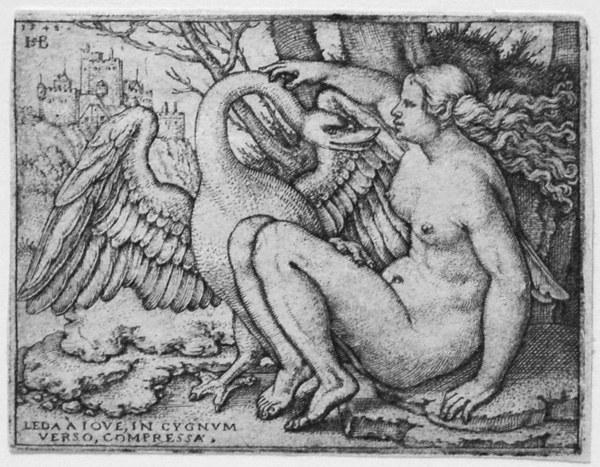 |
|
|
|
|
|
|
|
|
Hans Sebald Beham (German, 1500-1550), Leda and the Swan (Bartsch 112, Pauli 114 iii). Original engraving, 1545. A very good impression with thread margins nearly all around. Signed and dated in the plate top left; titled bottom left. From the collections of Furst zu Furstenberg. Image size: 46x61mm. Price: Please call or email for current pricing information.
|
|
|
|
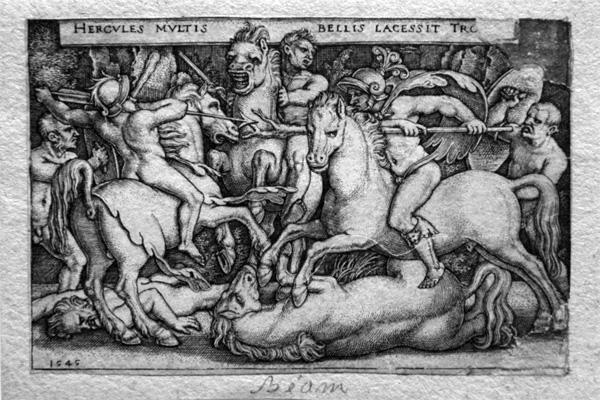 |
|
Hans Sebald Beham (German, 1500-1550), Hercules and the Trojans (Bartsch 101, Pauli 105). Engraving, 1545. Good impression with thread margins nearly all around; repaired paper loss top right corner with lost material drawn in by hand. This is one of a series on the Labors of Hercules. Image size: 50x78mm. Price: Please call or email for current pricing information.
|
|
|
|
|
|
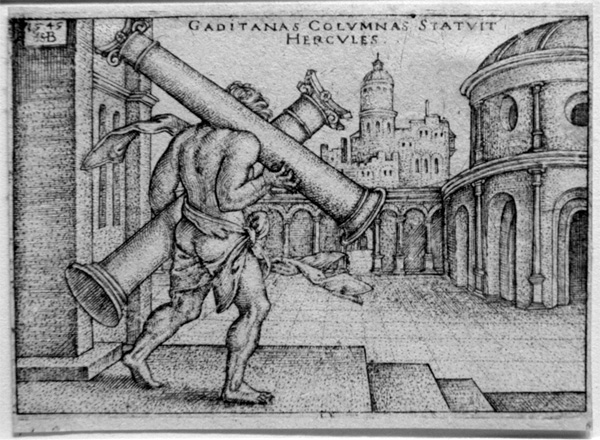 |
|
Hans Sebald Beham (German, 1500-1550), Hercules carrying the columns of Gaza (Bartsch 103, Pauli 101). Engraving, 1545. Good impression with thread margins nearly all around. This is one of a series on the Labors of Hercules. Image size: 49x71mm. Price: SOLD.
|
|
|
|
|
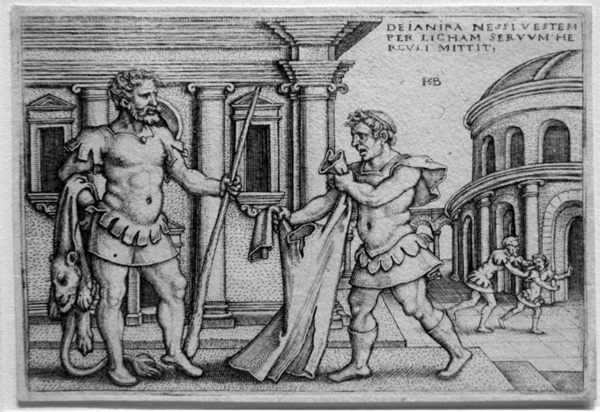 |
|
Hans Sebald Beham (German, 1500-1550), Hercules receiving the Shirt of Nessus from Lichas (Bartsch 98, Pauli 108). Engraving, 1546. Good impression with thread margins nearly all around. This is one of a series on the Labors of Hercules. Image size: 54x79mm. Price: Please call or email for current pricing information.
|
|
|
|
 |
|
Hercules on his funeral pyre (Bartsch 107, Pauli 99). Engraving, 1546. Good impression with thread margins nearly all around. This is one of a series on the Labors of Hercules. Image size: 49x71mm. Price: SOLD.
|
|
|
|
|
The story of Dido and Aeneas is one of the crucial episodes in Virgil's Aeneid. Aeneas, Venus' son, has been unable to sail to Italy, where he is destined to found Rome, because Juno has prevailed upon some of the gods to keep him from reaching his destination through storms and shipwreck. Juno does not want him to begin the process that will lead to the founding of Rome because she is worshiped by the Carthaginians and knows that ultimately Rome will destroy Carthage. Venus tries to reach a compromise: Aeneas will be made to fall in love with Dido, Queen of Carthage, marry her, found a dynasty, and be safe from the dangers of the seas and from the war that will result when he finally reaches the shores of Italy and claims the bride of Turnus for himself. Venus prevails upon Cupid to make Aeneas and Dido fall in love with each other. They are separated from the remainder of a hunting party by a divinely-created storm, take refuge in a cave, and consumate their marriage and their love. Aeneas is happy, Venus is happy, Juno is happy, and above all Dido is happy. Alas, it cannot be. As we know from Mel Brooks' Young Frankenstein, "Destiny, Destiny, no escaping Destiny!" Jupiter sends Mercury with the message that Destiny demands that Aeneas leave Dido and Carthage and go about fulfilling his destiny. Aeneas, who truly loves Dido, is heart-broken, but pius Aeneas (pious, god-fearing Aeneas) must follow the will of Jupiter, whose throne is dependent upon the Destinies, flees Dido, setting sail at night because he cannot bear her tears and fears her anger (hell, after all, hath no fury like a woman scorned). Dido discovers she has been abandoned, assumes that Aeneas is just another lascivious Trojan, finds herself rejected by the man she still loves, dishonored, about to be at the mercy of all of the local kings whose wooings she has rejected, and commits suicide, thus setting in motion the future awaiting its coming.
|
|
 |
|
|
|
Hans Sebald Beham (German, 1500-1550), Dido (Bartsch 80, Pauli 84). Original engraving, 1520. A good but light impression on laid paper of one of Beham's earliest engravings. Small margins outside the platemark. Illustrated in Eva/Ave: Images of Women in Renaissance Prints (National Gallery of Art, 1990), plate 12. H. Diane Russell singles this print out as "perhaps the most striking image of Dido in the exhibition. . . . Dido here wears a wreathlike crown referring to her royalty, while the flames of the pyre shoot up behind her, more like an aureole than a fire. These details seem to point to her glory, all the more poignant in comparison to her pose of absolute dejection. She is nearly nude, but she is not the idealized nude seen in most other prints of female suicide. Instead, it seems her clothing has fallen from neglect. Her face appears old and heavy, her body thick and slumping over the knife. This is not an image of a woman who is a symbol of chastity, but rather of a woman destroyed by passion, and it is not surprising that the artist gives his source as the fourth book of Virgil's Aeneid, adding the following inscription: 'This is the image of Queen Dido. O Evil Love, what do you not force human hearts to do?' " Image size: 117x90mm. Price: Please call or email for current pricing information.
|
|
|
|
|
|
|
|
|
|
|
|
|
The story of Lucrece's rape by Tarquin, the son of the usurping King of Rome and its consequence, the expulsion of the Tarquin line and the establishment of the Roman Republic, was first narrated by the Roman historian Livy and was well known and of much interest to artists, poets, and theologians alike during the Renaissance. Lucretia, chastest of Roman wives, is raped at knife point. She tells her husband and her father what has happened, asks them if she is guilty in any way. Yet upon being told by both that she is in no way guilty, she kills herself so that she will not be an excuse for unchastity in later Roman matrons. The question of guilt, however, leaves us in an interpretative dilemma first raised by St. Augustine’s discussion of Lucrece’s suicide in The City of God. Having argued, in the wake of the Visigoth sack of Rome and its accompanying rapes of multitudes of women (including “votaresses [i.e., nuns and abbesses] also” [I. 20]), that the despoiling of the body does not affect the sanctity of the mind, Augustine turns to the case of Lucretia, whose example he does not want others to imitate. After retelling Livy’s version of the story, he questions its conclusion, “And then, loathing the foulness of the fact [i.e., the deed, that which had been done] that had been committed upon her, she slew herself” (I. 23). “What?” asks St. Augustine, “shall we say she was an adulteress, or was she chaste? who will stand long in deciding this question? One, declaiming singularly well and truly hereof, saith thus: ‘Oh, wonder! there were two, and yet but one committed the adultery.’ . . . But what was it that then she punished so cruelly, not having committed any fault? . . . If it were no unchasteness in her to suffer the rape unwillingly, it was no justice to make her self away willingly” (I. 23). If Lucretia was innocent of unchastity, then she is guilty of murder: “this Lucretia being innocent, chaste, and forcibly wronged, even by Lucretia’s self was murdered” (I. 23). If she is not innocent of unchastity, then she is guilty of “lustful consent,” which she apparently “held it worthy to have punished with death (though she ought not to have done so . . . if she thought her repentance could be any way accepted of a sort of false gods)” (I. 24). Even if she were chaste, however, she shows herself by her self-murder no lover of chastity but of pride: “in killing herself for suffering uncleanness, being herself unpolluted, she showed no love unto chastity, but only discovered the infirmity of her own shame: she shamed at the filthiness that was committed upon her, though it were without her consent: and being a Roman and covetous of glory, she feared that what she had endured by violence should be thought to have been suffered with willingness” (I. 24; my emphasis). Augustine leaves Lucrece few options: to kill herself makes her guilty either of self-murder, unchastity, or Roman desire for glory.
Writing in 1528, about 1100 years later, William Tyndale uses Lucrece as an example of the rule that all deeds done before the Spirit of God comes are sinful: “Lucrece believed that if she were a good housewife and chaste, that she should be most glorious; and that all the world would give her honor and praise her. She sought her own glory in her chastity, and not God’s. When she had lost her chastity, then counted she herself most abominable in the sight of all men; and for very pain and thought which she had, not that she had displeased God, but that she had lost her honor, slew herself.”Shakespeare’s Lucrece (c. 1592) will support this interpretation; Lucrece is indeed concerned that she has lost her glory when she loses her honor, and Shakespeare shows us this in speeches such as Lucrece’s prayer to night not to let day “behold that face / Which underneath thy black all-hiding cloak / Immodestly lies martyr’d with disgrace!” (800-2) for fear that she will become an object of scorn. For an extended discussion of this issue, please see Andrew D. Weiner, "Burdens of Guilty Minds: Rape and Suicide in Shakespeare's Lucrece," Graven Images II: The Body (Madison: University of Wisconsin Law School, 1995), 48-63; the passage quoted occurs on pp. 50-51. Marcantonio Raimondi made an engraving after Raphael (c. 1511-12), and Aenea Vico made a reverse copy of Marcantonio's engraving. There were also engravings by Jacopo Francia (c. 1510), Master S (probably the first Northern engraving of the scene), Dürer did a drawing, but not an engraving, Hans Sebald Beham's first engagement with the subject, dates from 1519, Barthel Beham, Sebald Beham's younger brother, did an engraving (c. 1524), Heinrich Aldegrever treated the subject in 1539, Sebald Beham returned to the subject in an engraving of c. 1541-45, and Georg Pencz did an engraving (c. 1546-47). Perhaps the most outrageous depiction of the rape occurs in an engraving of the subject done by Agostino Veneziano de' Musi in 1524: on the left side of the engraving, Tarquin, knife in hand, climbs into Lucretia's bed as she tries to push him away; on the right side of the engraving, two dogs copulate.
|
|
 |
|
|
|
|
|
Hans Sebald Beham (German, 1500-1550), Lucretia Standing (Bartsch 18, Pauli 19 iia). Original engraving, c. 1541-45. A very good early impression on laid paper in excellent condition; trimmed on or just within the platemark. Ex-collection: "F. Lacoste 1799" written on verso, Illustrated in Eva / Ave: Women in Renaissance and Baroque Prints, plate 11. Image size: 74x46mm. Price: Please call or email for current pricing information.
|
|
|
|
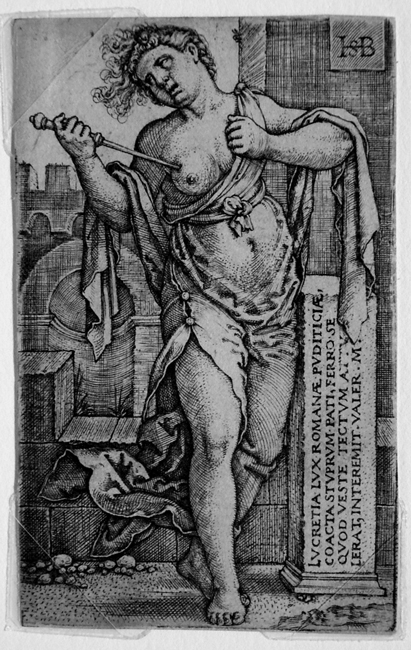 |
|
Hans Sebald Beham (German, 1500-1550), Lucretia Standing (Bartsch 18, Pauli 19 iv/iv). Original engraving, c. 1541-45. A very good early impression on laid paper in excellent condition; trimmed on or just within the platemark. Illustrated in Eva / Ave: Women in Renaissance and Baroque Prints, plate 11. Image size: 74x46mm. Price: Please call or email for current pricing information.
|
|
|
|
|
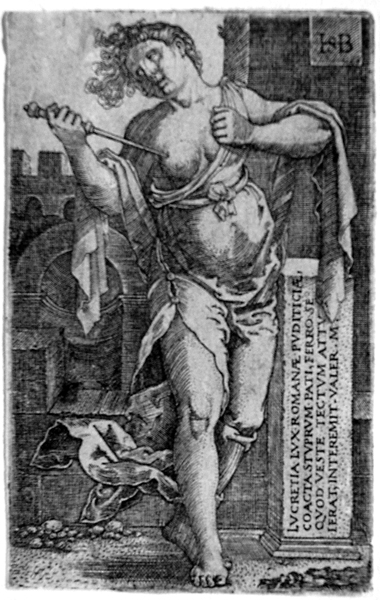 |
|
Hans Sebald Beham (German, 1500-1550), Lucretia Standing (Bartsch 18, Pauli 19 iia). Original engraving, c. 1541-45. A good early impression on laid paper with a bear watermark similar to Briquet 12327 manufactured in Geneva 1548-56; some wear visible in blank space over Lucrece's right hand in the upper left corner. Illustrated in Eva / Ave: Women in Renaissance and Baroque Prints, plate 11. Image size: 74x46mm. Price: Please call or email for current pricing information.
|
|
|
|
|
|
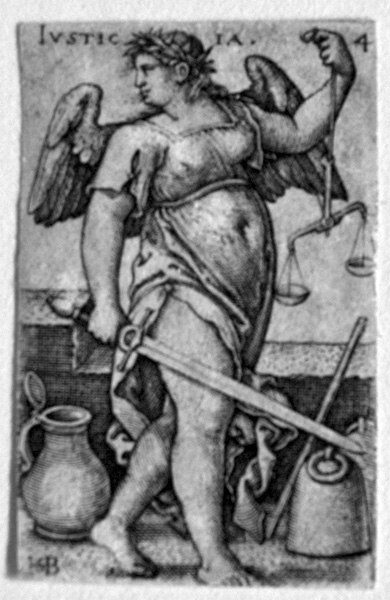 |
|
|
Hans Sebald Beham (German, 1500-1550), Iusticia / Justice (Bartsch 132, Pauli 134 ii/iv). Original engraving, 1539. A fine early impression on laid paper with margins originally published as part of a series on the Seven Virtues. Ex D'Arenberg Collection. Image size: 38x24mm. Price: SOLD.
|
|
|
|
|
|
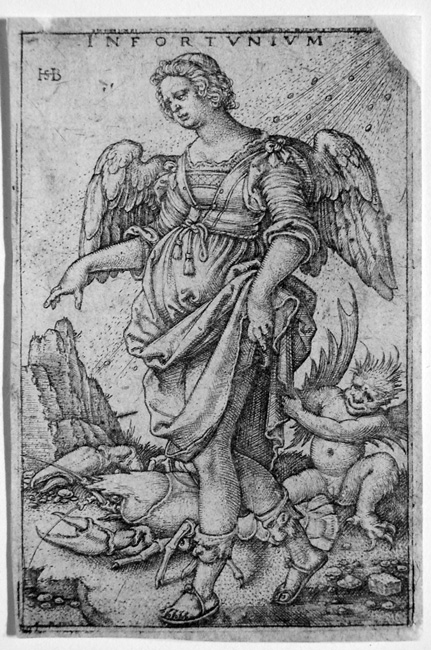 |
|
Hans Sebald Beham (German, 1500-1550), Infortvnivm / Misfortune (Bartsch 141, Pauli 144). Original engraving, c. 1541. A good impression with laid paper with a small paper loss top left mostly in the margin and a loss of the top right corner. A downcast winged figure walks with a lobster through a hail storm while a small winged devil tries to slow her down. Nothing seems to be growing in the landscape through which she passes. The hail suggests the possibility of divine displeasure, the slow-moving lobster keeping pace with misfortune and the devil impeding her progress suggests that misfortune can come as quickly as a hail storm but is slow in departing. Signed HSB in the plate top left, image size: 81x54mm. Price: Please call or email for current pricing information.
|
|
|
|
|
 |
|
Hans Sebald Beham (German, 1500-1550), Melencolia / Melancholy (Bartsch 144, Pauli 145 iii/vi ). Original engraving, 1539. A brilliant impression with small margins all around. From the collection of K. M. Bern with his collector's stamp lower left. Image size: 79x52mm. Price: SOLD.
|
|
|
|
 |
|
|
|
Hans Sebald Beham (German, 1500-1550), Triumphal Procession of the Noble Glorious Women (Bartsch 143, Pauli 244). Engraving, 1549 Good impression trimmed on or within the platemark. Signed and dated at the bottom. Maximilian I had a grand paper triumphal procession and a grand triumphal woodcut arch, to which Durer contributed mightily. Evidently, the urge for self-aggrandizement could be mnimalized even further! Image size: 22x138mm. Price: Please call or email for current pricing information.
|
|
|
|
|
|
|
|
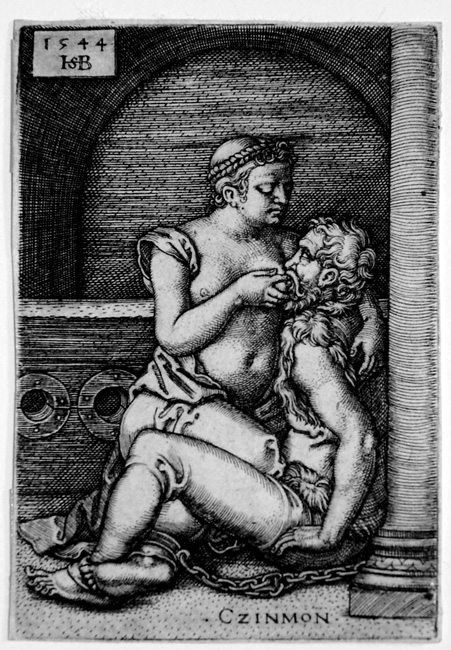 |
|
Hans Sebald Beham (German, 1500-1550), Cimon and Pero (Bartsch 75, Pauli 79 i/iii). Original engraving, 1544. A very fine impression of the first state of three (before the engraving on the column) on laid paper of this rare print, trimmed on or within the platemark. Signed and dated 1544 in the plate top left. This engraving deals with a subject sometimes called "Roman Charity": Pero's father Cimon is in prison, sentenced to death by starvation. Pero saves her father from starvation by offering her breast milk to him. She is found out by a jailer, but her act of selflessness impresses officials and wins her father's freedom. See Valerius Maximus, Nine Books of Memorable Acts and Sayings of the Ancient Romans. Image size: 72x48mm. Price: Please call or email for current pricing information.
|
|
|
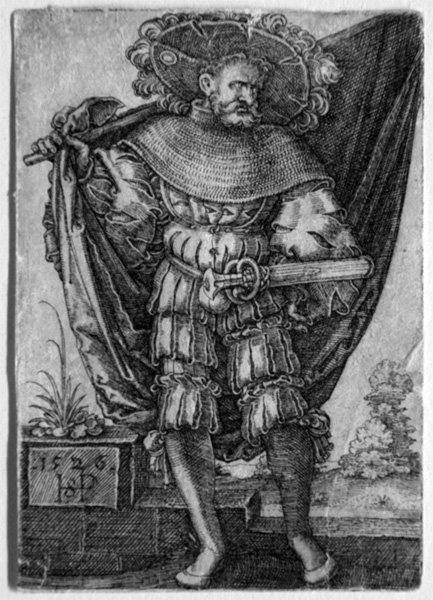 |
|
|
|
Hans Sebald Beham (German, 1500-1550), The Standard Bearer (Bartsch 200 i/ii, Pauli 203). Original engraving, 1526. A good impression with some abrasions and showing signs of wear. Signed and dated in the plate lower left. Image size: 79x52mm. Price: Please call or email for current pricing information.
|
|
|
|
|
|
 |
|
Hans Sebald Beham (German, 1500-1550), Coat of Arms with a Rampant Lion (Bartsch 225, Pauli 266). Engraving, 1544. very good impression of this rare print trimmed on or within the platemark. Signed and dated at the bottom. Image size: 67mm hexagon. Price: Please call or email for current pricing information.
|
|
|
|
Spaightwood Galleries, Inc.
To purchase, call us at 1-800-809-3343 (1-508-529-2511 in Upton MA & vicinity) or send an email to spaightwood@gmail.com. We accept AmericanExpress, DiscoverCard, MasterCard, and Visa.
For directions and visiting information, please call. We are, of course, always available over the web and by telephone (see above for contact information). Click the following for links to past shows and artists. For a visual tour of the gallery, please click here. For information about Andy Weiner and Sonja Hansard-Weiner, please click here. For a list of special offers currently available, see Specials.
Visiting hours: Saturday 10:00 am to 5:00 pm and Sunday noon to 6:00 pm and other times by arrangement. Please call to confirm your visit.
Browsers and guests are welcome.
|
|
|
|
|
|
|
|
|
|
|
|
|
|
|
|
|
|
|
|
|
|
|
|
|
|
|
|
|
|
|
|
|
|
|
|
|
|
|
|
|
|
|
|
|
|
|
|
|
|
|
|
|















